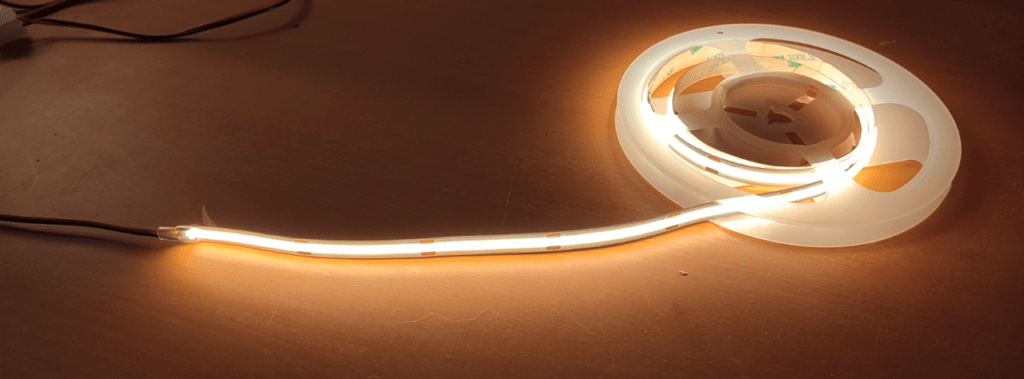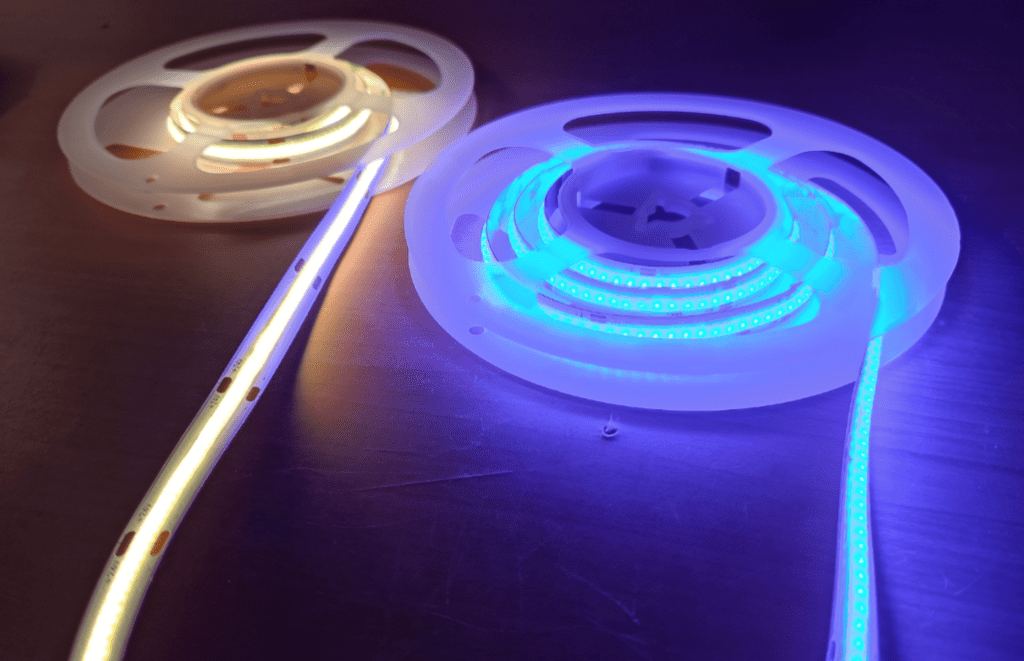Sorry about that, I remember a famous (at least in the Northeast of England) AD for J.T. Doves – a Builder’s Merchant who’s catch-phrase (in a Northern accent) was (and probably still is) J.T. Doves – for all your household requirements. I couldn’t resist paraphrasing that for the blog title. Being a Geordie, the company name LEDYi interests me – read on.
So really, what is this all about? No I’m not an “affiliate” or on commision (let’s get that out of the way). Like many of you I’ve been using LED STRIP for years, that is: 5v serial RGB strip as well as 12v single colour or 12v RGB (or even RGBW and RGBWW) strip, consisting of a thin plastic tape containing up to 60 LEDs per metre…. you know the stuff. I use it everywhere, above my desk, in the pergola, under kitchen cabinets – you name it. More typically I use single-colour LED strip (often white) for general lighting.
I’ve fitted the stuff into several houses over time – and seen guys light up entire streets at Christmas with it using (as one example) the excellent free PC program XLIGHTS and at a smaller scale the again free and excellent wLED software which runs on an ESP8266 or ESP32 to run (for example) WS2812B serial LED strip lighting etc. Going way back in time, I wrote some routines for ESP8266-based ESP-GO to sequence WS2812B lighting to make some candle-effect lighting for Christmas – but that’s ancient history.
In case you’ve been living in a cave (like me) 5v serial RGB strip typically has 3 wires, ground, 5v and signal. You send a high speed data signal down the signal line and the LEDs can be individually controlled to produce some frankly WONDERFUL effects previously impossible – but I digress. The 12v strip is a lot simpler, with (typically) a common+ and a negative for each colour (or just plus and minus for single-colour strip).
I often use something called an H801 controller for the latter – a cheap box from AliExpress and others which consists of an ESP8266 in a box with 5 MOSFETS – connectors include Ground, VCC, R, G, B, W1 and W2. In my case I put the free, open-source Tasmota firmware on these devices and they are GREAT – VCC can be anything from 5V up to and including 24v and each output can handle several amps.
I’ve written all about the H801 elsewhere in here. My pergola has several 5 metre lengths of RGB 5050 strip (and some white) running off one of these units and a 12v supply. Oh, I should say that the outputs can be individually used as PWM for brilliance control.
I was idling away a few weeks ago and as happens, things started to go through my head, like “I’m sick of the rubbish adhesive they use on this stuff”, “I wonder if they use higher voltages in industry to allow for longer lengths of strip?” and “I should try some of the new(ish) COB lighting”. COB means “chip on board” incidentally.
What’s the relevance of that last comment? Well, LED COB strip, instead of having a mere 60 LEDS or less per metre, has LOTS more in order to give the impression of CONTINUOUS light. It’s not QUITE sci-fi-level perfect but with care, they actually can achieve this continuous effect and it’s LOVELY.
Honestly, I just STUMBLED onto LEDYi on the web – they do a range of 24v LED COB and other kinds of strip – do check the link – I’m not affiliated with them in ANY way but I feel obliged to thank them for what they sent – and much as I’d love to rant about the subject in here, their website – link above – tells you so much more about the variations of LED lighting they make than I have time for. So, feeling brave, I dropped them a line and asked if I could have a couple of samples of their COB strip to play with.
And that’s what I expected – a couple of bits of LED strip – what I GOT was a large box of 1 metre samples – I guess I owe them thanks – this will keep me occupied for hours and satisfy my need to know more. (I’m easily pleased when it comes to colour lighting).
Ok, enough corporate – the LEDYi site above will tell you all you need to know about specs, different LED lighting, colours etc., I take no responsibility for anything I’ve not used – so that means most of their vast range of lighting – but back to the point – COB – one sample – WARM WHITE – 2700K, consumption 15W per metre (no such thing as a free lunch) – a massive 480 LEDs per metre…. and IP20 waterproof. And here it is…

That warm white 1m length above takes 100ma at 24v (2.4W near enough – so even with the moer densely packed lighting I can get away with a thinner power lead than 5v lighting) as measured on my pretty standard, cheap Chinese Korad bench PSU.
Sitting in front of the sample, I could make out the LEDs but as you can see, from any distance it actually DOES look continuous. I can see this sample ending up under my bench once I’m done here. 2.4W for under-bench lighting seems reasonable.
Turns out my camera isn’t as good as my eyes as you can see here a short length of the strip which illustrates (I hope) how simple it would be to cut custom short pieces of the COB strip, much like normal 5050 strip – similar distance but not every 3 LEDs – meanwhile, the camera cannot make out the individual LEDs – my eyes can – just. But hey, this is SO much more Star-Trek than the more traditional LED strip (they probably used fluorescent lighting in the earlier Star Treks) – shame 24v power isn’t quite as readily available (I refer to old phone chargers, modem PSUs and other surplus supplies lying around in cupboards etc.) – you can of course buy just about any voltage power supply.
Strangely, on a number of occasions I’ve come across garden lighting with 24v supplies. Garden – there’s a thought… mind you – the pack specs gave the impression of waterproof to my non-industrial mind – but those copper connectors don’t look protected to me. Maybe a quick coat of clear spray.
AHAH, I’ve just been educated – “For example, using the listing below, IP20 means you are protected against solid objects up to 12mm… but there is no protection against liquids…” – ok so this sample isn’t waterproof. I HAVE to share this random link with you – protected against my finger but not water…
Questions? That strip above runs BARELY warm and in terms of width – about 10mm overall, 3mm actual light. Isn’t that pretty? The sample you see above is WARM white – possibly hard to tell from the photo – but trust me – showing you the coloured strip is going to be harder. It just occurred to me, my otherwise stunning phone camera doesn’t have decent colour balance control…
They also sent me some RGB strip with a wopping great 840 LEDs per metre, but I’m afraid the continuous effect is not quite so good – as they’ve used individual colours per LED rather than RGB LEDs – take a look… I left the WHITE attached in the hope the camera doesn’t redesign the view. Yup. With blue only selected you can (close-up anyway) see the individual LEDs. Still, WAY better than what came before and from any distance – this is very near to continuous.
Here’s a thing – they also supplied me with (as well as warm and cold white, red, green and blue), orange and yellow samples – now, both yellow and orange (in particular the former) when constructed from RGB send to look a bit naff – but in this case, using the individual colour strips, take my word for it – the colours are CLEAN. Pointless showing photos as they’ll end up looking nothing like the eye sees.. even that blue above is a pale imitation of what you actually get 🙂
Hope you enjoyed that as much as I’m going to enjoy redesigning my office lighting.





